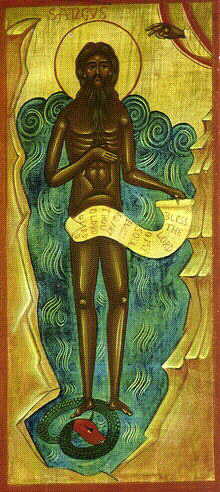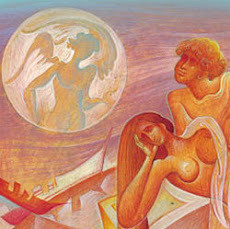
A first approach to the indigenous Orthodox Saints and Martyrs of the Ancient Church who lived and who propagated the Faith in the British Isles and Ireland during the first millennium of Christianity and prior to the Great Schism is being attempted in our website in our desire to inform our readers, who may not be aware of the history, the labours or the martyrdom of this host of Orthodox Saints of the original One, Holy, Catholic and Apostolic Church of our Lord.
"The Church in The British Isles will only begin to grow when she begins to venerate her own Saints" (Saint Arsenios of Paros †1877)
To Aengus many ascribe the reform of Irish monasticism and its emergence as an ordered ascetic and scholastic movement. He is called the Culdec because this reform produced the groups of monks in Ireland and Scotland, who were really anchorites but lived together in one place, usually thirteen in number after the example of Christ and His Apostles. The name Culdec probably comes from the Irish Ceile Dee (companion) rather than the Latin Cultores Dei (worshippers of God).
The Culdees produced the highly decorated High Crosses and elaborately illuminated manuscripts which are the glory of the Irish monasteries.
Image from: http://www.bluffton.edu/~sullivanm/muiredach/muiredach.html
Aengus was born of the royal house of Ulster and was sent to the monastery of Clonenagh by his father Oengoba to study under the saintly abbot Maelaithgen. He made great advances in scholarship and sanctity but eventually felt he had to leave and become a hermit to escape the adulation of his peers. He chose a spot some seven miles away for his hermitage which is still called Dysert.
He lived a life of rigid discipline, genuflecting three hundred times a day and reciting the whole of the Psalter daily part of it immersed in cold water, tied by the neck to a stake. At his dysert he found he got too many visitors and went to the famous monastery of Tallaght near Dublin, without revealing his identity, and was given the most menial of tasks. After seven years a boy sought refuge in the stable where Aengus was working because he was unable to learn his lessons. Aengus lulled him to sleep and when he awoke he had learnt his lesson perfectly.
When the abbot of St. Maelruain heard of this monk's great teaching gifts he recognised in him the missing scholar from Clonenagh and the two became great friends. It was at Tallaght that Aengus began his great work on the calendar of the Irish saints known as the Felire Aengus Ceile De. As for himself he thought that he was the most contemptible of men and is said to have allowed his hair to grow long and his clothing to become unkempt so that he should be despised. Besides the Felire one of his prayers asking for forgiveness survives, pleading for mercy because of Christ's work and His grace in the saints.
Like all the holy people of God, Aengus was industrious and had a supreme confidence in His power to heal and save. On one occasion when he was lopping trees in a wood he inadvertently cut off his left hand. The legend says that the sky filled with birds crying out at his injury, but St. Aengus calmly picked up the severed hand and replaced it. Instantly it adhered to his body and functioned normally.
When St. Maelruain died in 792, St. Aengus left Tallaght and returned to Clonenagh succeeding his old teacher Maelaithgen as abbot and being consecrated bishop. As he felt death approaching he retired again to his hermitage at Dysertbeagh, dying there about 824. There is but scant evidence of the religious foundations at Clonenagh or Dysert but he will always be remembered for his Feliere, the first martyrology of Ireland.
http://www.oodegr.com/english/biographies/arxaioi/Angus%20of%20Culdee.htm















































Δεν υπάρχουν σχόλια:
Δημοσίευση σχολίου